What's inside
What's inside
 Key Ingredients
Key Ingredients

No key ingredients
 Benefits
Benefits

 Concerns
Concerns

 Ingredients Side-by-side
Ingredients Side-by-side

Water
Skin ConditioningStearic Acid
CleansingPEG-8
HumectantMyristic Acid
CleansingPotassium Hydroxide
BufferingGlycerin
HumectantLauric Acid
CleansingButylene Glycol
HumectantAlcohol Denat.
AntimicrobialOlea Europaea Fruit Oil
MaskingHoney Extract
HumectantAvena Sativa Meal Extract
SoothingCalendula Officinalis Flower Extract
MaskingLaurus Nobilis Leaf Extract
MaskingPEG-100 Stearate
Glyceryl Stearate
EmollientPolyquaternium-7
Parfum
MaskingDisodium EDTA
Theobroma Cacao Extract
Skin ConditioningCaprylic/Capric Triglyceride
MaskingWater, Stearic Acid, PEG-8, Myristic Acid, Potassium Hydroxide, Glycerin, Lauric Acid, Butylene Glycol, Alcohol Denat., Olea Europaea Fruit Oil, Honey Extract, Avena Sativa Meal Extract, Calendula Officinalis Flower Extract, Laurus Nobilis Leaf Extract, PEG-100 Stearate, Glyceryl Stearate, Polyquaternium-7, Parfum, Disodium EDTA, Theobroma Cacao Extract, Caprylic/Capric Triglyceride
Water
Skin ConditioningGlycerin
HumectantLauryl Hydroxysultaine
CleansingPotassium Cocoyl Glycinate
Coco-Glucoside
CleansingSodium Cocoyl Alaninate
Acrylates/C10-30 Alkyl Acrylate Crosspolymer
Emulsion StabilisingPotassium Hydroxide
BufferingSodium Benzoate
MaskingSalicylic Acid
MaskingEthylhexylglycerin
Skin ConditioningDisodium EDTA
Anthemis Nobilis Flower Oil
MaskingVetiveria Zizanoides Root Oil
MaskingDipropylene Glycol
HumectantButylene Glycol
HumectantCarnitine
CleansingSerine
MaskingArginine
MaskingCitric Acid
Buffering1,2-Hexanediol
Skin ConditioningMelaleuca Alternifolia Flower/Leaf/Stem Extract
Skin ConditioningGluconolactone
Skin ConditioningHydrolyzed Hyaluronic Acid
HumectantWater, Glycerin, Lauryl Hydroxysultaine, Potassium Cocoyl Glycinate, Coco-Glucoside, Sodium Cocoyl Alaninate, Acrylates/C10-30 Alkyl Acrylate Crosspolymer, Potassium Hydroxide, Sodium Benzoate, Salicylic Acid, Ethylhexylglycerin, Disodium EDTA, Anthemis Nobilis Flower Oil, Vetiveria Zizanoides Root Oil, Dipropylene Glycol, Butylene Glycol, Carnitine, Serine, Arginine, Citric Acid, 1,2-Hexanediol, Melaleuca Alternifolia Flower/Leaf/Stem Extract, Gluconolactone, Hydrolyzed Hyaluronic Acid
Ingredients Explained
These ingredients are found in both products.
Ingredients higher up in an ingredient list are typically present in a larger amount.
Butylene Glycol (or BG) is used within cosmetic products for a few different reasons:
Overall, Butylene Glycol is a safe and well-rounded ingredient that works well with other ingredients.
Though this ingredient works well with most skin types, some people with sensitive skin may experience a reaction such as allergic rashes, closed comedones, or itchiness.
Learn more about Butylene GlycolDisodium EDTA plays a role in making products more stable by aiding other preservatives.
It is a chelating agent, meaning it neutralizes metal ions that may be found in a product.
Disodium EDTA is a salt of edetic acid and is found to be safe in cosmetic ingredients.
Learn more about Disodium EDTAGlycerin is already naturally found in your skin. It helps moisturize and protect your skin.
A study from 2016 found glycerin to be more effective as a humectant than AHAs and hyaluronic acid.
As a humectant, it helps the skin stay hydrated by pulling moisture to your skin. The low molecular weight of glycerin allows it to pull moisture into the deeper layers of your skin.
Hydrated skin improves your skin barrier; Your skin barrier helps protect against irritants and bacteria.
Glycerin has also been found to have antimicrobial and antiviral properties. Due to these properties, glycerin is often used in wound and burn treatments.
In cosmetics, glycerin is usually derived from plants such as soybean or palm. However, it can also be sourced from animals, such as tallow or animal fat.
This ingredient is organic, colorless, odorless, and non-toxic.
Glycerin is the name for this ingredient in American English. British English uses Glycerol/Glycerine.
Learn more about GlycerinPotassium hydroxide is commonly known as caustic potash. It is used to fix the pH of a product or as a cleaning agent in soap. In cleansers, it is used for the saponification of oils.
Sapnification is the process of creating fatty acid metal salts from triglycerides and a strong base. During this process, Potassium Hydroxide is used up and is not present in the final product.
Using high concentrations of Potassium Hydroxide have shown to irritate the skin.
Learn more about Potassium HydroxideWater. It's the most common cosmetic ingredient of all. You'll usually see it at the top of ingredient lists, meaning that it makes up the largest part of the product.
So why is it so popular? Water most often acts as a solvent - this means that it helps dissolve other ingredients into the formulation.
You'll also recognize water as that liquid we all need to stay alive. If you see this, drink a glass of water. Stay hydrated!
Learn more about Water